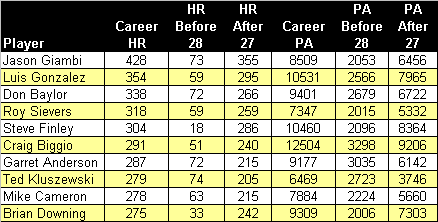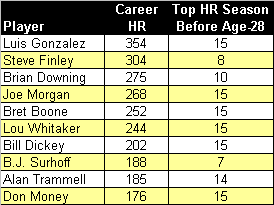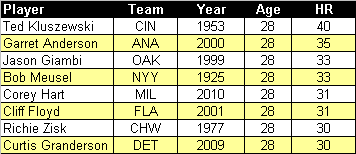
At the beginning of March, Dodgers’ first baseman James Loney talked confidently about being a legitimate candidate for the batting title in 2012. Considering how many people view him as a disappointment, not to mention he has never even hit over .300 in a qualified season, Loney’s optimism was intriguing to say the least. So, last week, I took a look at other batting champions who had never hit .300 before their 28th birthday and, not surprising, discovered very few.
Before writing about Loney’s pursuit of a batting crown, I hadn’t given the first baseman much thought. However, while listening to Vin Scully broadcast a recent Dodgers’ spring training game, the left handed hitter was thrust to the forefront once again. During the game, Scully relayed a story about adjustments Loney had made that the lefty believed would allow him to hit for more power…even as many as 30 home runs this season. Once again, for a player who had never hit more than 15, Loney seemed guilty of wishful thinking.
Career Home Run Leaders Among Late Bloomers*

*Includes players with at least 2,000 PAs before their age-28 season who hit 75 or fewer homers.
Source: baseball-reference.com
Since 1901, 685 players (including Loney) with at least 2,000 plate appearances hit 75 or fewer home runs before their age-28 season. From this group, only 31 went on to hit more than 200 home runs in their entire career. Going one step further, only seven batters from this segment hit more than 200 long balls without having recorded more than 15 homers in a season during this timeframe. In other words, if Loney does turn on the power, it will qualify as a historical achievement.
Career Home Run Leaders Among Even Later Bloomers*

*Includes players with at least 2,000 PAs before their age-28 season who hit 75 or fewer homers and never more than 15 in any one season.
Source: baseball-reference.com
To be fair, Loney only implied that he could hit 30 home runs in a season. However, even this accomplishment would go against the tide of history because only 27 players (in 50 seasons) from the group of 685 defined above wound up having their first 30 home run season after turning 28. What’s more, most of those hitters gradually worked their up to 30 home runs, whereas Loney would have to double his output in order to reach that level in 2012.
Late Bloomers* Who Had First 30 Home Run Season at Age-28

*Players with at least 2,000 PAs and no more than 75 homers before their age-28 season.
Source: baseball-reference.com
The list above includes three players who offer Loney some immediate hope. For most of his Yankees’ career, Bob Meusel was a productive, but often overlooked member of Murders’ Row. That’s what happens when you play alongside Lou Gehrig and Babe Ruth. By their standards, Meusel wasn’t really a power hitter, but in reality, his more modest totals were still good enough to rank among the league leaders. In 1925, when Gehrig was just breaking in and Babe Ruth was suffering from “the bellyache heard around the round”, Meusel finally was the top dog. That season, the left fielder belted 33 homers to lead the league. It would be the highest total of his career and only his second season with more than 16.
With bulging biceps exposed by his trademark sleeveless uniform, Ted Kluszewski became synonymous with power. And yet, Big Klu was a late convert to the long ball. In 2,723 plate appearances before turning 28, the muscular first baseman only had 74 home runs, or only seven more than Loney. Over the next four years, however, he hit 171, including 40 or more in three consecutive seasons. During that span, no one hit more home runs than Kluszewski, but thanks in large part to several nagging injuries, the slugger’s power quickly dissipated as he combined to hit only 34 home runs in his last five seasons.
Garrett Anderson vs. James Loney, Pre Age-28 Seasons
Source: baseball-reference.com
Before turning 28, Garrett Anderson’s statistics were very similar to Loney’s. So, if the pattern holds, the Dodgers’ first baseman just might be in line for a breakout power season. In 2000, Anderson, who had only once hit more than 16 homers (21 in 1999), belted 35 long balls, beginning a four-year stretch in which he flirted with that plateau in each season. Considering the similarities, maybe the Dodgers can just go ahead and pencil in more power from first base?
If Los Angeles has a little patience, the real poster boy for late power is Steve Finley. Before entering his age-31 season, the left handed centerfielder had only 47 home runs in nearly 4,000 plate appearances. Then, all of a sudden, he flipped the switch. Not only did Finley belt 30 long balls as a 31-year old in 1996, but he maintained his power over the remainder of his career.
At the rate he is going, James Loney will enter the season convinced he can win the triple crown. Has he made a believer out of you? I am still skeptical, but for the first time, I’ll be keeping a close eye on Loney’s pursuit of history.
Oh, by the way, did I mention this is Loney’s contract year? Ironically, if the Dodgers first baseman does have the breakout season he is predicting, it could mean the end of his days in Los Angeles, especially with teammate Andre Ethier also headed for free agency. Almost 10 years ago, the Dodgers faced a similar situation when Adrian Beltre parlayed a career season into a big free agent contract with another team. The Dodgers were wise to let Beltre go back then, but this time around, a big season from Loney might compel the new ownership group to keep him. In that respect, a lot more than just history is riding on Loney’s 2012 season…millions of dollars are at stake as well.











![10845__stayingalive_l[1]](http://www.bronxbanterblog.com/wordpress/wp-content/uploads/2012/03/10845__stayingalive_l1.jpg)
![michael-pineda-camp[1]](http://www.bronxbanterblog.com/wordpress/wp-content/uploads/2012/03/michael-pineda-camp1.jpg)

![1524_0040im_2006-03-09[1]](http://www.bronxbanterblog.com/wordpress/wp-content/uploads/2012/03/1524_0040im_2006-03-091-1024x682.jpg)
![215th-Street-Stairs-2010[1]](http://www.bronxbanterblog.com/wordpress/wp-content/uploads/2012/03/215th-Street-Stairs-20101-1024x768.jpg)
![215th-Street-Stairs-August-29.1915-New-York-Herald[1]](http://www.bronxbanterblog.com/wordpress/wp-content/uploads/2012/03/215th-Street-Stairs-August-29.1915-New-York-Herald1.jpg)
![215th-Street-Steps-in-1916.[1]](http://www.bronxbanterblog.com/wordpress/wp-content/uploads/2012/03/215th-Street-Steps-in-1916.1.jpg)












